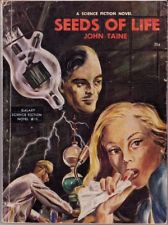
Seeds of Life is the last of those Galaxy Science Fiction Novels I found in my basement this summer. “John Taine” is the pseudonym of Eric Temple Bell, a mathematician and scientist. Seeds of Life is a variation on the Jekyll and Hyde theme. A technical assistant is zapped by radiation in a laboratory and is transformed into genius. Initially, the genius builds incredible devices that make millions of dollars. But the genius goes to the Dark Side and his evil threatens to unleash new horrors on the United States. Written in 1931, Seeds of Life has some of the stilted prose of that era. But even 80 years ago, John Taine was suggesting that radiation could have devastating mutating effects. Science shows up in Erie Temple Bell’s other “John Taine” science fiction novels. The best known were published in an omnibus edition by Dover Press: The Time Stream; The Greatest Adventure; and The Purple Sapphire. If you’re in the mood for some Old School SF adventures, these John Taine novels fit the bill.
Are Seeds of Life and Seeds of Time alternate titles for the same book?
Deb, you are the best editor I know! Once again, my brain refused to recognize an error in a book title. Thanks for the heads up!
Very interesting that the radiation menace was already in place – thanks George, new author for me.
Sergio, I’ve had SEEDS OF LIFE for decades. But I finally got around to reading it. Sure, it’s dated, but SEEDS OF LIFE was cutting edge stuff in 1931.
Stilted prose of that era in the hands of the beginning (usually) fiction-writers (including Bell/Taine) who were drawn to the Gernsback magazines and their immediate heirs (while, in distinction, the initial issues of ASTOUNDING STORIES OF SUPER SCIENCE, as it was first titled and first edited by Harry Bates, was attempting to play up the already strong pulp traditions in sf, as usually seen in adventure and eclectic pulps…but Bates soon gave way, when ASTOUNDING was bought by Street and Smith from the collapsing Clayton chain, to F. Orlin Tremaine’s editorship and a somewhat more literate version of Gernsbackian gosh-wow…not that Gernsback had ever been allergic to publishing good prose–he did publish H. G. Wells and Poe reprints–so much as being oblivious to that as being a primary draw).
Todd, all the John Taine SF novels from the Thirties that I’ve read are heavy on “science.” Of course, plenty of Taine’s scientific speculations seem funny in retrospect, but occastionally–like the radiation motif in SEEDS OF LIFE–Taine was right on the money. During that era in SF magazines, science played a more prominent role. Adventure and sociology dominated the SF of the Fifties. Plenty of experimentation in SF during the Sixties and Seventies. Loved Cele Lalli’s editorship of AMAZING and FANTASTIC! She worked magic on a shoe-string budget!
Or, of course, those issues of ASTOUNDING were trying to play up pulp sf, from its 1930 foundation for its first few years and the Clayton chain collapse. Tremaine might be the only other key sf editor aside from Cele Lalli to have spent a chunk of his career as a women’s magazine editor (albeit Lalli was in the more specific focus of bridal magazines…Tremaine, slightly less probably, was with Desmond Hall (who also worked on ASTOUNDING with Tremaine), the editor of MADEMOISELLE from 1935-37.
It’s amusing to note that the Legendary editors of both ASF and MLLE were the ones who followed Tremaine…JW Campbell and Betsy Blackwell. Also, coincidentally, both those successors left their magazines in 1971…Blackwell, happily for her, simply retired, rather than dying suddenly.
The only full length Taine I’ve read is Time Stream, though I think I remember short stories in some venue or other by him. I don’t recall being that impressed, but then I wasn’t impressed by Weinbaum’s Martian Oddessy either, and for a long time it was considered a classic. Maybe still is.
Rick, I had the same impression of Weinbaum’s MARTIAN ODYSSEY. I’m sure MARTIAN ODYSSEY and SEEDS OF LIFE were cutting-edge books for their time, but they’ve aged badly.
Oops, that should have been Odyssey.
Sometimes I like the stilted prose. It beats some of what passes for writing these days, a lot of which seems like it’s on about a third-grade level.
Kelly, I know what you mean. I’m a big fan of 19th Century novels: Dickens, Trollope, etc. I love their prose style. Too many of our 21st Century writers seem to write tweets instead of sentences.
It probably helped that I read “A Martian Odyssey” as a child, but in magazine sf as it was in 1937, the Weinbaum debut story was an offhanded trend-setter that helped set the field on its ear…Heinlein and Campbell both took serious lessons from it, in their collective and several efforts to further a naturalistic approach to the fantastic, the lean Hammett/Hemingway/Bloch approach that those other worthies were demonstrating or about to do so in their respective fields. Even the ethnic jokes, a bit heavy-handed but not mean-spirited, were the kind of thing that seemed an unusual influx of narrative sophistication for contributors to (and readers of) WONDER STORIES at the time. That’s a good chunk of why the story leads off the first volume of THE SCIENCE FICTION HALL OF FAME (where a more sober approach, or at least a less parochial one on the part of SFWA back when, might’ve given that slot to a Wells story).
Todd, I read A MARTIAN ODYSSEY (Lancer edition) as a teenager. For its time, it must have been a revelation.
And, I err–it was in a 1934 issue of WONDER STORIES.
http://gutenberg.net.au/ebooks06/0601191h.html